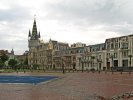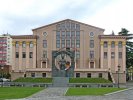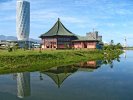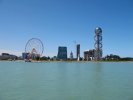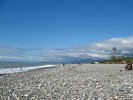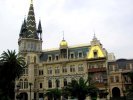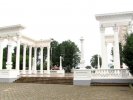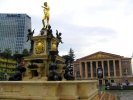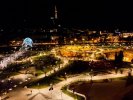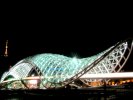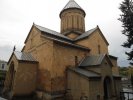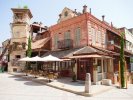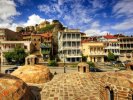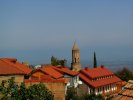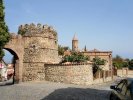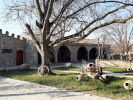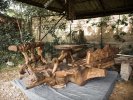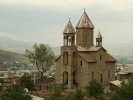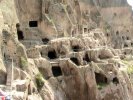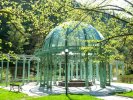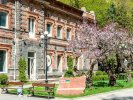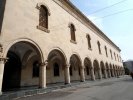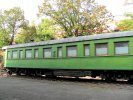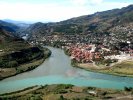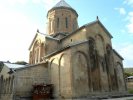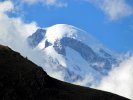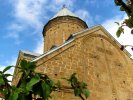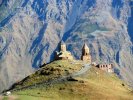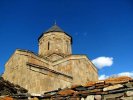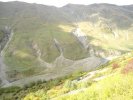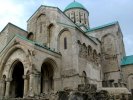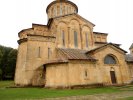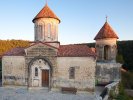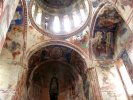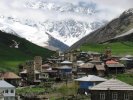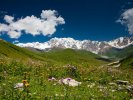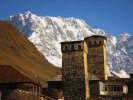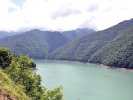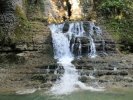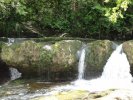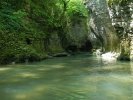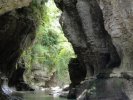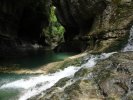|
||||||||||||||||||||||||||||||||||||||||||||
All Georgia from Batumi (12 days)
Batumi – Tbilisi – Bodbe – Sighnaghi – Manavi – Vardzia – Akhaltsikhe – Borjomi – Mtskheta – Gori – Uplistsikhe – Ananuri – Gudauri – Kazbegi – Kutaisi – Zugdidi – Mestia – Ushguli – Kutaisi – Martvili canyon – Batumi (12 days, 11 nights)
Day 1: Batumi
Arrival to Batumi. Meeting with the representatives of the agency. Hotel accommodation. Overnight.
Day 2: Batumi – Tbilisi
Breakfast. Batumi – is a "Georgian Singapore", the most famous seaside resort of Georgia with a population of 120,000 people. Visiting card of Batumi, a popular place for residents and guests of the city, – is Batumi Piazza, built in 2009. In 2010, the decoration of the city has become the new, 7 meters high, moving sculpture of Love. The statue is a figure of a woman and a man. They aspire to each other for 8-10 minutes is very original and beautiful move towards each other and eventually merge as one. Excursion in the city: animated fountains (laser show), Argonauts square with Medea statue.
Transfer to the railway station. Departure to Tbilisi by train. Welcome dinner. Overnight.
Day 3: Tbilisi
Breakfast. Panoramic tour in Tbilisi. The capital of Georgia is unique. It is located on the several mountain hills, on which "creep" the old blocks. Tbilisi – is a beautiful river Kura with its picturesque rocky shores, that flows across the whole city. "Old Town" – is the historic center of Tbilisi, that is located at the root of Mtatsminda (Holy Mount) mountain. Almost all of the buildings of the Old Town are historical and cultural sites, this part of the city is round – the – clock full of life, here walk alone or in groups tourists, meet lovers near the Clock Tower. This amuzing Tower appeared here recently, built by the Puppet Theatre director Rezo Gabriadze. Here artists exhibit their paintings, artisans offer numerous souvenirs. There are mainly 2-3-storey houses built of stone and brick, and they have a special Tbilisi architecture, which is characterized by narrow streets, galleries and carved wooden balconies. Tbilisi is one of the rare places in the world, where can peacefully exist in the Old Town orthodox church, catholic cathedra, synagogue and mosque.
During the excursion visit of: Mechetian Church( V c.), Anchiskhati Basilica of St Mary – the oldest surviving church, Synaxis of Saint Truinity, temple complex of Tsminda Sameba – the main Cathedral of Georgian Orthodox Church. The rise by the cable car (tickets for extra charge) to the Narikala fortress ( IV c.).
Overnight.
Day 4: Tbilisi – Bodbe – Sighnaghi – Manavi – Tbilisi
Breakfast. Departure to"town of everlasting love"Sighnaghi. On the way visit in the Bodbe village of the monastery complex of St. George and the grave of St. Nino, that brought Christianity to Georgia.
Walk along the ancient town Sighnaghi, that is placed at the top of the ridge, overlooking Alazani valley. It was currently restored to its original from. Then, passing through, acquaintance with the history of the Manavi Fortress (XI century) and the Manavi Temple (XVIII century). The church was built in 1794 by the abbot of the monastery of John the Baptist from the monastery David Gareji - Ephraim. In the 17th century here was located the royal vineyards and the estate of Heraclius II. Stop in the pearl of Kakheti - a private estate "Chateau Fort de Manavi". In the program of the visit: tasting of wines and chacha, produced according to traditional old Georgian technology directly in the marani "Chateau Fort de Manavi" from grapes grown in the estate's own vineyards. The highlight of the tasting will be "Manavi Green" - a wine made from a special grape variety that grows only in the area of the village of Manavi in Georgia. In the evening there is an opportunity to have dinner in traditional Georgian style (for extra charge). The menu includes only Georgian cuisine from ECO products grown on the "Chateau Fort de Manavi" farm.
Return to Tbilisi. Overnight in the hotel.
Day 5: Tbilisi – Vardzia – Akhaltsikhe – Borjomi – Tbilisi
Breakfast. In the morning departure to Vardzia. Visit of Vardzia cave monastery complex (XII- XIII c.) – 19 stepped rock town. For 900 m along the left bank of Kura river, in the plumb wall of the mountain, around 600 buildings are cut out – churches, chapels, parrocks, pantries, baths, libraries. There preserved secret passages, remains of plumbing, and irrigation system. Vardzia - is the site of the era of Golden Age. More than thousands of monks lived there, and when being attacked, to 20 thousand of people could shelter there.
Next, drive to recently reconstructed Akhaltsikhe fortress, the motherland of Charles Aznavur, the ancient center of Catholicism in Georgia. In the complex, together with Orthodox Church of St. Marina, are placed mosque, catholic church and monastery of Benedictine Sisters, synagogue and Armenian church. Departure to Borjomi. We will taste of the worldknown mineral water Borjomi from the spring. Return to Tbilisi. Overnight.
Day 6: Tbilisi – Mtskheta – Gori – Uplistsikhe – Tbilisi
Breakfast. Excursion in Mtskheta. Visit of temple- monastery Jvari ( VI c.). At the top of the mountain, where the temple is located, opens a fantastic view on the place of confluence of two rivers – Kura and Aragvi. There also opens a beautiful view on the ancient capital of Georgia – Mtskheta. Visit of Svetitskhoveli Cathedral (1010-1029), at the bottom of which is buried one of the major Christian relics Lords chiton, as well as the burial place of many of the Georgian kings. Here is also the part of life-giving pillar. Visit of Samtavro monastery, where year round grow, flower and fruit blackberry bush, near of which in the IV century lived and preached St. Nino- enlightener, the first preacher of Christianity in Georgia. The official adoption of Christianity in Georgia in 324 is associated with the name of St. Nino, with the assistance and participation of the King St. Miriam and Queen St. Nana. It was St. Nino who persuaded the king Miriam and queen Nana to adopt Christianity in Georgia. Woderworking icon of Iberian Mother of God, woderworking icon of St. Nino, grave of St. Tsar Merian and Tsarina Nani, hallows of St. Abibos Nekresky, St. Shio Mhvimskoho are inside. Visit the Stalin museum (tickets for extra charge). Museum consists of three blocks – museum, house and railway carriage. Next, excursion to Uplistsikhe (I centuries BC) – a wonderful cave town, that was finishing the building for centuries, and included more than 700 caves and buildings, including wineries, bakeries, antique theater, hall of receptions of Queen Tamara, preserved to this day. Return to Tbilisi. Overnight.
Day 7: Tbilisi – Ananuri – Gudauri – Kazbegi – Kutaisi
Breakfast. In the morning, departure from Tbilisi in the direction of Stepantsminda (Kazbegi). On the way to it, we will overlook the picturesque Ananuri fortress(XVI c.), located above Aragvi river, and also the amazing beauty of Zhinvali reservoir. In passing the ski resort Gudauri(2200 m), the stunning trip along Tergi river, through Cross Pass (2400 m), will bring us to Stepantsminda (Kazbegi). Excursion in Kazbegi: church of the Holy Gergeti Trinity Church (2170 m above the sea level). When the weather is fair, the stunning view on the mountain Kazbek (5147 m), one of the highest tops of Georgia, opens. Deprture to Kutaisi. Overnight.
Day 8: Kutaisi
Breakfast. Excursion in the ancient city Kutaisi, that is more than 3 thousand years old. Visit of Gelati monastery and academy, established by the great Georgian tsar David IV the Builder. Gelati Monastery has preserved a great variety of wall paintings dating back to XII-XVIII centuries. Therefore, the most wonderful in the architecture of Gelati complex is its frescoes and mosaics, that return the all gone days and remind us about its creators.Then excursion to the Cathedral of Bagratithat was erected in Kutaisi during the reign of Bagrat III, was named after the first king of united Georgia, as a main palace of the kingdom, was consecrated in 1003. Both Gelati monastery and Academy and Bagrati Cathedral are included to the number of World Heritage sites by UNESCO. Then, visit of the "monastery of accomplishment of desires" Motsameta. Monastery overlooks the Rioni river surrounded by rugged coastal vegetation. The legend says that this small monastery stands on the place of the execution of the Georgian kings David and Constantine Mkheidze by Muslims, because they were faithful to Christianity. Prince David and Constantine are canonized, their relics are stored in a large rectangular ark on a dais in the small hall of the monastery. There is a legend among the tourists, that if you ask the holy princes something, crawl under the ark three times and venerate to their relics, your wish will come true.
Excursion to the Prometheus cave, where we recall the legend of Prometheus. According to the legend, Prometheus gave the fire to people, and because of that he was enchained to the rock. The cave is located 5 km northwest of the city of Tskhaltubo. It was discovered in the early 80's of the twentieth century. It is one of the most attractive caves, thanks to its underwater rivers and landscapes. Here are almost all underwater karst forms: stalactites, stalagmites, and others.
Overnight.
Day 9: Kutaisi – Zugdidi – Mestia
Breakfast. Departure to Zugdidi. The treasure of Zugdidi is graceful patrimonial palace of Dadiani princes, with great park. At the present time, it is a museum with uncommon historical collection, icluding the death mask of Napoleon Bonaparte. The oldest aristocratic family of Dadiani princes is known for its relations with Napoleon Bonaparte. In Vlakherna church, in Zugdidi, is kept one of the most precious Christian relics – Cincture of the Virgin Mary – christian relic, that belonged to Virgin Mary, mother of Jesus Christ. On the way to Mestia, we can enjoy the fantastic views of four waterfalls and three mountain peaks of the Caucasus – Ushba, Mazera, Shkhelda. Hotel accommodation in Mestia. Dinner. Overnight.
Day 10: Mestia – Ushguli – Kutaisi
Breakfast. Excursion in Mestia, that is included to the in the number of World Heritage sites by UNESCO.Visit of the historic- ethnographical museum, medieval church and fortification districts of Mestia.
Departure to Ushguli. Excursion in Ushguli – Svanetian village located at an altitude of 2200m above sea level, the most high-mountain permanent settlement in Europe, included to the World Heritage sites List of UNESCO. Visit of Ushguli museum of icons, Towers of Queen Tamara, Ushguli Ethnographic Museum. Return to Kutaisi. Overnight.
Day 11: Kutaisi – Martvili canyon – Batumi
Breakfast. Visit one of the unique natural attractions of Georgia – Martvili canyon. Over millions of years, the water has created breathtaking gorgein in limestone rocks, reaching a depth of 40 meters, at the bottom of which actually the river flows. The total length of the canyon is one kilometer available to reach. In the upper part of the canyon, you can take a boat trip and reach the very beginning with 7 meter high powerfulwaterfall. Due to the extremely humid microclimate there are lianas hanging from the huge rocks and centuries-old walls are covered with moss. Here and there water pulls out from the rocky wall forming small streams and pretty powerfull waterfalls.
Boat trip for extra charge.
After this, the canyon Kehura – distance 15km. Here you can dive into the water.
Departure to Batumi. Overnight.
Day 12: Batumi
Breakfast. Depending on the departure time, spare time. Souvenirs buying. Transfer to the airport for your flight to back home.
* in summer you can stay for vacation in Batumi. See below in the table the cost for extra nights.
Beware! You are not authorized to view hidden text. The price includes:
The price does not include:
Additional services require pre-order!
|
||||||||||||||||||||||||||||||||||||||||||||
| Order Now | Become a Partner | Additional conditions |


